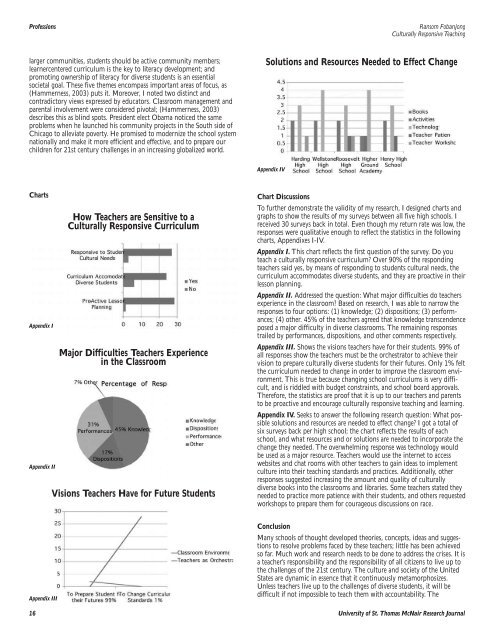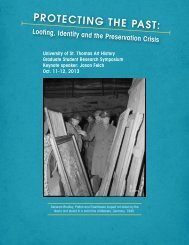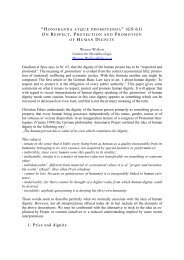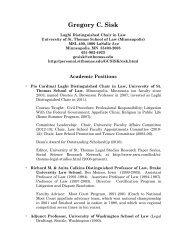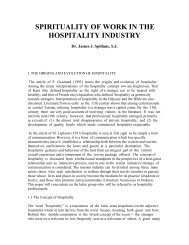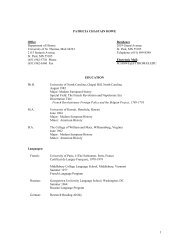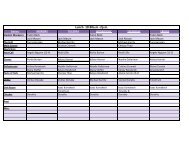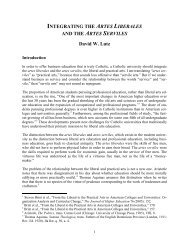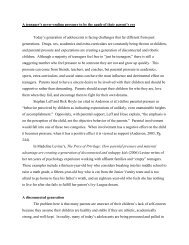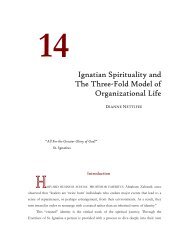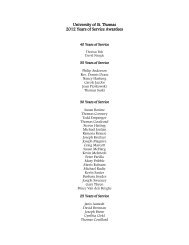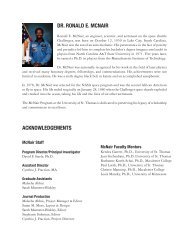McNair Research Journal - University of St. Thomas
McNair Research Journal - University of St. Thomas
McNair Research Journal - University of St. Thomas
You also want an ePaper? Increase the reach of your titles
YUMPU automatically turns print PDFs into web optimized ePapers that Google loves.
Pr<strong>of</strong>essions<br />
larger communities, students should be active community members;<br />
learnercentered curriculum is the key to literacy development; and<br />
promoting ownership <strong>of</strong> literacy for diverse students is an essential<br />
societal goal. These five themes encompass important areas <strong>of</strong> focus, as<br />
(Hammerness, 2003) puts it. Moreover, I noted two distinct and<br />
contradictory views expressed by educators. Classroom management and<br />
parental involvement were considered pivotal; (Hammerness, 2003)<br />
describes this as blind spots. President elect Obama noticed the same<br />
problems when he launched his community projects in the South side <strong>of</strong><br />
Chicago to alleviate poverty. He promised to modernize the school system<br />
nationally and make it more efficient and effective, and to prepare our<br />
children for 21st century challenges in an increasing globalized world.<br />
Charts<br />
Appendix I<br />
Appendix II<br />
Appendix III<br />
How Teachers are Sensitive to a<br />
Culturally Responsive Curriculum<br />
Major Difficulties Teachers Experience<br />
in the Classroom<br />
Visions Teachers Have for Future <strong>St</strong>udents<br />
Solutions and Resources Needed to Effect Change<br />
Appendix IV<br />
Ransom Fobanjong<br />
Culturally Responsive Teaching<br />
Chart Discussions<br />
To further demonstrate the validity <strong>of</strong> my research, I designed charts and<br />
graphs to show the results <strong>of</strong> my surveys between all five high schools. I<br />
received 30 surveys back in total. Even though my return rate was low, the<br />
responses were qualitative enough to reflect the statistics in the following<br />
charts, Appendixes I-IV.<br />
Appendix I. This chart reflects the first question <strong>of</strong> the survey. Do you<br />
teach a culturally responsive curriculum? Over 90% <strong>of</strong> the responding<br />
teachers said yes, by means <strong>of</strong> responding to students cultural needs, the<br />
curriculum accommodates diverse students, and they are proactive in their<br />
lesson planning.<br />
Appendix II. Addressed the question: What major difficulties do teachers<br />
experience in the classroom? Based on research, I was able to narrow the<br />
responses to four options: (1) knowledge; (2) dispositions; (3) performances;<br />
(4) other. 45% <strong>of</strong> the teachers agreed that knowledge transcendence<br />
posed a major difficulty in diverse classrooms. The remaining responses<br />
trailed by performances, dispositions, and other comments respectively.<br />
Appendix III. Shows the visions teachers have for their students. 99% <strong>of</strong><br />
all responses show the teachers must be the orchestrator to achieve their<br />
vision to prepare culturally diverse students for their futures. Only 1% felt<br />
the curriculum needed to change in order to improve the classroom environment.<br />
This is true because changing school curriculums is very difficult,<br />
and is riddled with budget constraints, and school board approvals.<br />
Therefore, the statistics are pro<strong>of</strong> that it is up to our teachers and parents<br />
to be proactive and encourage culturally responsive teaching and learning.<br />
Appendix IV. Seeks to answer the following research question: What possible<br />
solutions and resources are needed to effect change? I got a total <strong>of</strong><br />
six surveys back per high school; the chart reflects the results <strong>of</strong> each<br />
school, and what resources and or solutions are needed to incorporate the<br />
change they needed. The overwhelming response was technology would<br />
be used as a major resource. Teachers would use the internet to access<br />
websites and chat rooms with other teachers to gain ideas to implement<br />
culture into their teaching standards and practices. Additionally, other<br />
responses suggested increasing the amount and quality <strong>of</strong> culturally<br />
diverse books into the classrooms and libraries. Some teachers stated they<br />
needed to practice more patience with their students, and others requested<br />
workshops to prepare them for courageous discussions on race.<br />
Conclusion<br />
Many schools <strong>of</strong> thought developed theories, concepts, ideas and suggestions<br />
to resolve problems faced by these teachers; little has been achieved<br />
so far. Much work and research needs to be done to address the crises. It is<br />
a teacher’s responsibility and the responsibility <strong>of</strong> all citizens to live up to<br />
the challenges <strong>of</strong> the 21st century. The culture and society <strong>of</strong> the United<br />
<strong>St</strong>ates are dynamic in essence that it continuously metamorphosizes.<br />
Unless teachers live up to the challenges <strong>of</strong> diverse students, it will be<br />
difficult if not impossible to teach them with accountability. The<br />
16 <strong>University</strong> <strong>of</strong> <strong>St</strong>. <strong>Thomas</strong> <strong>McNair</strong> <strong>Research</strong> <strong>Journal</strong>


